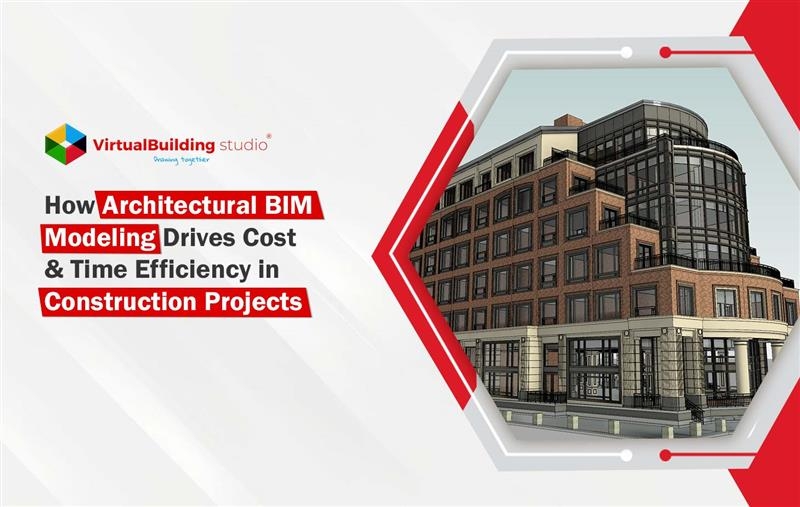
Imagine a mid-rise commercial building project stuck due to design changes, budget overruns, contractor miscommunication, and delayed approvals. For many architects and builders, this is a frustratingly familiar scenario. As construction projects grow more complex, with tighter budgets and accelerated timelines, the demand to deliver on time and within budget has reached an all-time high.
Traditional 2D workflows and siloed design methods often fall short in addressing these modern challenges.
Introducing architectural BIM modeling, a transformative approach that equips architects and project stakeholders with a coordinated, intelligent 3D environment. By using BIM modeling tools like Revit, firms can simulate, visualize, and validate every design decision before a single brick is laid. The result? Fewer change orders, faster approvals, and optimized resource planning.
In this article, we will explore how BIM modeling for Architects is redefining efficiency, delivering smarter designs, faster execution, and significant cost savings across the AEC industry.
What is Architectural BIM Modeling?
Architectural BIM modeling is the process of creating intelligent, data-rich 3D models that represent the physical and functional aspects of a building’s design. It allows architects to plan, design, visualize, and document a project with enhanced accuracy and coordination.
Unlike traditional CAD, BIM modeling services in architecture provide a collaborative environment where every element, such as walls, doors, windows, and systems, is embedded with real-time data and relationships.
Key Tools Used:
Revit for parametric 3D modeling, Navisworks for clash detection, AutoCAD for 2D detailing, Enscape and Twinmotion for real-time visualization, and BIM 360 (Autodesk Construction Cloud) for cloud collaboration
Role of 3D BIM Modeling in Modern Construction:- Early clash detection and reduced rework.
- Faster design validation and approvals.
- Accurate quantity take-offs and cost estimation.
- Improved project planning and on-site execution.
By leveraging Architecture BIM services, design teams can boost project efficiency, reduce risks, and deliver high-quality outcomes aligned with client goals and timelines.
How Architectural BIM Modeling Enhances Cost Efficiency
In today’s competitive AEC industry, keeping project costs under control is as critical as design quality and construction speed. BIM modeling services empower architects and project teams to make data-driven decisions that significantly reduce budget overruns and optimize resource usage from concept to completion.
Accurate Quantity Take-offs with BIM Modeling Services
Traditional quantity estimations are prone to manual errors and inconsistencies. With BIM modeling services, quantity take-offs are automated and linked directly to model elements. This ensures real-time accuracy in material calculations for concrete, steel, glass, or finishes. By reducing guesswork, teams can better forecast costs, minimize contingencies, and avoid unexpected budget escalations.
Clash Detection in 3D Revit BIM Modeling
Design conflicts between architectural, structural, and MEP elements often lead to costly rework on-site. 3D Revit BIM modeling offers advanced clash detection capabilities that flag these issues during the design phase, long before construction begins. Resolving clashes virtually saves significant time and expense that would otherwise be spent on change orders, re-engineering, and project delays.
Resource Optimization with BIM Modeling for Architects
Smart modeling allows architects to fine-tune designs for material efficiency. BIM modeling for architects supports lean construction by enabling the use of standardized building components, prefabrication, and just-in-time material delivery. This reduces waste, lowers procurement costs, and improves overall construction logistics. The ability to simulate construction sequences further helps in reducing idle time and labor costs.
Lifecycle Cost Analysis Using Architectural BIM Services
Beyond initial construction, architectural BIM services also contribute to long-term cost savings. BIM facilitates energy modeling, daylight analysis, and sustainability assessments that inform energy-efficient design decisions. Architects can evaluate the lifecycle cost of different systems and materials, helping owners invest in solutions with lower maintenance and operational costs.
By integrating cost analysis into every stage of the design and construction process, Building Information Modeling (BIM) services offer unparalleled visibility and control over project finances. It’s not just about building efficiently, it’s about building smarter, with every dollar accounted for.
How BIM Modeling Improves Time Efficiency in Architecture
Time is one of the most valuable resources in any construction project. BIM modeling services empower architects and project teams to work smarter, faster, and more collaboratively, accelerating project timelines from concept to completion.
Faster Design Iterations with 3D BIM Modeling
Traditional design workflows often rely on disconnected files and manual revisions, slowing down the approval process. With 3D BIM Modeling, design changes are instantly updated across all project views and documentation. This parametric modeling capability allows architects to explore multiple design options quickly, make informed decisions, and keep pace with client feedback and regulatory requirements.
Real-Time Collaboration Among Stakeholders
One of the biggest time-drains in construction projects is miscommunication. BIM modeling services provide a centralized digital platform where architects, engineers, contractors, and owners can collaborate in real-time. Cloud-based tools like BIM 360 allow teams to share models, track changes, and resolve queries without delay, leading to faster approvals and coordinated execution.
Reduced Rework via BIM Modeling Services
Errors discovered during construction often cause expensive and time-consuming rework. With early clash detection and model validation, BIM Modeling Services help identify design and coordination issues before they reach the site. This proactive approach minimizes disruptions and change orders, keeping projects on schedule.
4D Scheduling with 3D Revit BIM Modeling
Time efficiency extends beyond design. 3D Revit BIM modeling supports 4D simulation by linking model elements with time-based schedules. Construction teams can visualize each phase of the project, anticipate logistical challenges, and optimize resource allocation. This visual planning enhances site coordination and reduces the risk of delays due to sequencing conflicts.
Prefabrication Support Through BIM Modeling for Architects
BIM modeling also facilitates off-site construction methods like prefabrication and modular assembly. Detailed and accurate BIM models provide manufacturers with the information needed for precise fabrication. Components arrive on-site ready for installation, cutting down construction time and improving overall efficiency.
By integrating design, planning, and execution on a single platform, architecture BIM services empower project teams to move faster without sacrificing quality. The result is a streamlined construction process that meets deadlines, reduces downtime, and enhances client satisfaction.
Challenges and Limitations of Architectural BIM Modeling in Cost and Time Savings
While Architectural BIM Modeling is widely recognized for its potential to reduce project costs and timelines, achieving these benefits isn’t always straightforward. Several challenges can limit the efficiency gains firms expect from BIM implementation.
Lack of Skilled BIM Professionals
Not all design teams have access to trained BIM experts. Without in-depth knowledge of BIM tools, standards, and coordination practices, modeling errors and delays can increase, ultimately impacting cost and schedule targets.
High Initial Investment and Learning Curve
Adopting BIM involves upfront costs for software, training, and infrastructure. For small to mid-size firms, the time required to train teams and adapt workflows may offset early-stage efficiency gains.
Inconsistent Modeling Standards
Without clearly defined standards and level of development (LOD) expectations, different teams may produce inconsistent models. This can result in coordination issues, rework, and inefficient model usage during construction.
Limited Interdisciplinary Coordination
Although 3D BIM modeling supports collaboration, its full benefits are realized only when all project stakeholders use BIM effectively. If only the architectural team works in BIM while consultants use traditional methods, coordination gaps can persist.
Time Zone and Communication Gaps in Global Teams
In remote collaborations or when outsourcing, time zone differences and miscommunication can delay feedback, approvals, or design changes, negatively affecting timelines.
Understanding these challenges is key to unlocking the full potential of Architecture BIM Services. With the right expertise, technology alignment, and collaboration practices, firms can overcome these hurdles and truly harness BIM’s promise of cost and time efficiency.
The Smart Solution to Overcome BIM Challenges in Architecture
To overcome these limitations, many firms are now turning to Dedicated BIM Resources, remote architects who integrate into your workflows and deliver consistent, high-quality output. At Virtual Building Studio, we provide access to the top 1% US-trained, vetted architectural BIM modelers who bring global experience, deep technical knowledge, and code-compliant modeling proficiency.
By supplementing your team with skilled professionals through architecture BIM services, you can eliminate delays, ensure modeling accuracy, and scale effortlessly, maximizing both cost and time savings across your projects.
Conclusion
BIM modelling in architecture is no longer just a design tool; it's a strategic advantage in delivering high-performance projects on time and within budget. By enabling accurate quantity takeoffs, early clash detection, streamlined scheduling, and real-time collaboration, BIM modeling services help reduce risk, eliminate costly rework, and accelerate decision-making across all project stages.
With the growing complexity of construction projects, the firms that invest in BIM are better positioned to stay competitive, efficient, and future-ready. Whether it's improving design coordination or supporting modular construction, Revit 3D modeling empowers architects to lead with precision and confidence.
To maximize the value of BIM and overcome in-house resource constraints, consider extending your team with remote architects. These vetted architects integrate seamlessly into your workflows, delivering speed, quality, and cost efficiency without the overhead of full-time hiring.




